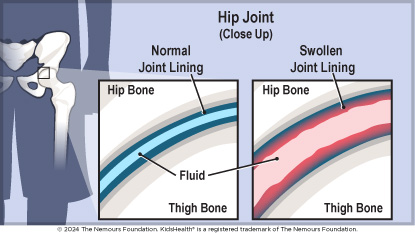Transient synovitis (sin-uh-VEYE-tis) is inflammation of one or both hips that mostly affects kids younger than 10 years old. The hip joint gets extra fluid in it and a swollen lining. This causes hip pain and limited movement of the joint, so kids who have it might walk with a limp.
Transient synovitis usually doesn't cause long-term problems, and most kids feel better within 7–10 days. Sometimes it can take a few weeks for symptoms to completely go away.


Follow the package directions for how much to give and how often. If you don't know the recommended dosage or your child is younger than 2 years old, call your health care provider.

Your child:


How do kids get transient synovitis? Experts don't know the exact cause of transient synovitis (also called "toxic synovitis"). Often, it happens after a child has a cold or diarrhea illness, so it might happen because the body's immune system was fighting an infection.
How is transient synovitis diagnosed? Health care providers will check for transient synovitis when a child has pain in one or both hips, pain in the knee or thigh, or a limp. After doing an exam, they'll order some tests, such as an ultrasound and blood tests. Sometimes testing on the fluid in the hip joint is needed. After making sure there isn't a more serious cause of the hip pain, they can make the diagnosis of transient synovitis.
Can my child get transient synovitis again? Yes. Kids who get transient synovitis may get it again during childhood. If your child has hip or leg pain, or gets a limp again, tell their health care provider that they've had transient synovitis before.